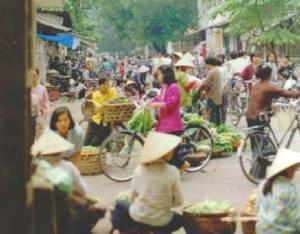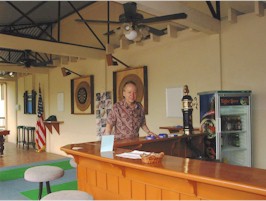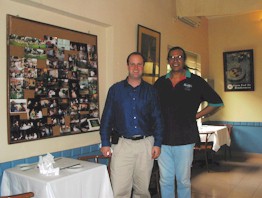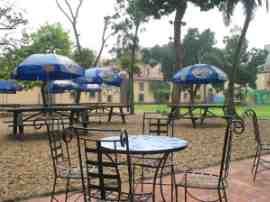
HANOI – A RETURN TRIP
TEN
YEARS AFTER THE LIFTING OF THE U.S. EMBARGO
President Bill Clinton lifted the U.S. Embargo with Vietnam in March
1993. I was a U.S. diplomat at the time and serving as U.S.
Special Negotiator
for Vietnam. In fact, I was in Vietnam at the time meeting with
Vietnam for the U.S. on multiple issues necessary preparatory to
opening diplomatic relations. I spent the next three years in
Vietnam taking back the
keys to the former U.S. Embassy in Saigon and other properties,
witnessing
settlement of U.S.-Vietnam Private Claims and helping to establish and
nurture
our U.S.-Vietnam relationship.
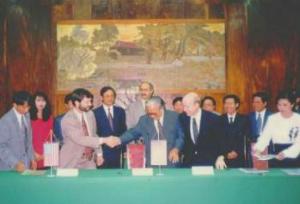
|
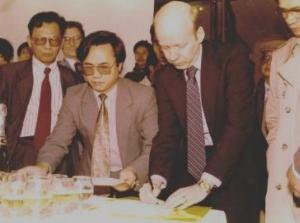 |
Contract signing
between a U.S. firm and the Vietnamese Ministry of Transport
|
Ministry of Foreign
Affairs Officials of Vietnam and I sign documents transferring
properties to the
U.S.
|
On the tenth anniversary of this event I thought it
made sense to take another look at how Hanoi and Vietnam in general had
changed and therefore was pleased when the Vietnam Resource Group asked
me to lead a group of U.S. companies to participate in Viet Expo 2004
plus help to
teach a seminar for Vietnamese businesses on better use of the internet
and e-commerce to expand their company’s economic outreach. James
Rockwell, a longtime friend and the first U.S. businessman to receive a
license by the Vietnamese government to operate a business in Vietnam
(a
license for Consulting and later Trading) and who along with his wife
and
first son had experienced Vietnam perhaps even more fully over a six
year
period from 1992-1998 but who now resides in Idaho where he is a
stockbroker
agreed to join me as did my wife who had taught at the U.N.
International
School in Hanoi during our stay and now heads our internet and website
division
of the company.
We flew to Vietnam with Cathay Pacific through Hong Kong which is
probably the easiest and quickest way to make the trip with direct
service to Hong Kong from San Francisco or Los Angeles and only a two
hour lay over before a connecting flight. Arriving in Hanoi’s Noi
Bai airport, we were
all surprised to see a brand new air conditioned international terminal
with modern piers had replaced the old dismal terminal where the air
conditioning
and frequently most everything else didn’t work. Even more of a
change, several of the immigration officers actually smiled and
welcomed us to Hanoi.
On the road into Hanoi which has also been rebuilt, billboards
advertised all sorts of products and we passed two industrial parks
which showed that modern international industry is a basic part of life
in the North. Further in we passed the “Water Park”, a Vietnamese
amusement park with
rides that was new before hitting the city proper. Here the city
looked
less changed although there are now several modern office buildings and
a number of four and five star hotels.
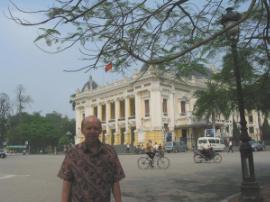 |
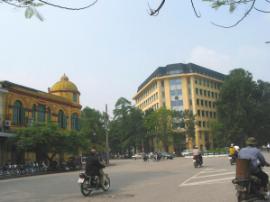 |
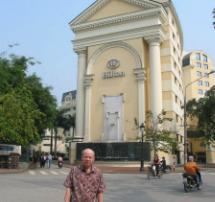
|
Hanoi Now - The Hanoi
Opera House
|
The Press Club
building
|
Hilton Hanoi Opera
Hotel
|
We stayed at the Hilton Hanoi Opera which is still to my belief Hanoi’s
best hotel primarily because its location puts it only a short walk to
so many good restaurants and gives one a chance to stroll the city
streets where so much of Hanoi life actually takes place. The
Daewoo, the Sofitel and the Sheraton have equally imposing physical
plants but not the neighborhood ambience that is to be found in the
city center. At the hotel, we
called and talked with Al DeMatteis who has been an institution in
Hanoi
and has spent nearly 12 years there. During this period, Al has
probably
given back more to the community (both foreign and Vietnamese) than
most
if any other westerner by actively volunteering and participating in
most
community activities and through contributing to orphanages, churches
and
other charities.
We joined Al for a drink at the American Club which stands on U.S.
government property and was formerly the site of the pre-1954 U.S.
Consulate in Hanoi. Later the compound was Headquarters to the
Fatherland Front that helped
to coordinate resistance to U.S. and South Vietnamese forces during the
Vietnam War. The property was returned to the U.S. in 1993 and
the
two main buildings on the site were raised due to the fact that the
buildings
were so deteriorated from lack of maintenance and insect damage that
repair
was not an option. An underground air raid bunker from the
American
War period on the property was filled and grass planted and the
property
now rings to the voices of young Western and Vietnamese children who
enjoy
the clean surroundings which are a sharp contrast to Hanoi’s parks
which
often are littered with needles and drug paraphernalia or the litter of
illicit
sex, two vices that have proliferated in recent years according to many.
Al DeMatteis told us that we had missed by one day the reception hosted
by the American Chamber of Commerce to commemorate ten years of
AmCham activities in Hanoi. James Rockwell and I both had hoped
to make this event as James and Al were the original founders of the
AmCham and had our office of their intention to start such an
organization shortly after the initial idea had come to them both.
Over the next days, I toured the city, met with people from the
Vietnamese government, U.S. Embassy and the Diplomatic community.
Many of the
Vietnamese I met started their conversations with me with the remark
“Have
you seen all the changes!” The truth was that there are a number
of
new office buildings and also a sprinkling of new hotels that we
visited
– the Sheraton, the Nikko, the Sofitel and others but really not the
building
boom that one would expect for a ten year period. Rusting green
sheet
metal still surrounds several failed joint venture real estate projects
and
although the traffic is notably worse, much of the old flavor of the
city
remains. Jogging mornings around Hoan Kiem Lake in the pre-dawn,
the
area still teams with thousands exercising either to tai chi, aerobics,
running,
badminton or other activities. There has been much rebuilding of
smaller
structures but mostly Hanoi remains less changed than most Asian cities
which
is not necessarily a bad thing.
In talking with Vietnamese government officials, U.S. Embassy staff,
western bankers and financiers, Vietnamese and American Businessmen,
all readily
admit that although there has been considerable investment in Vietnam,
the
promise has not met reality. All acknowledged
that
international investment (FDI) was dropping and that many high profile
projects
failed to become reality as investors succumbed to the Asian Financial
Crisis
or their own over optimism. Newly committed foreign-direct
investment
capital decreased dramatically by 60 percent from 1996 to $3.1 billion
in
2003. Further, the Ministry of Planning and Investment has
reported
that by the end of 2003, they have liquidated more than 1,000 FDI
projects
before schedule, with an aggregate registered capital of $12.3 billion
and
accounted for 18.6 percent of the total projects by number and 23
percent
by dollar volume.
A further problem was that the investment was not being made evenly
throughout the country. Since the lifting of the trade embargo,
according to
several western financial investment companies perhaps as much as 60%
has
gone into Ho Chi Minh City or the surrounding area with arguably only
20%
going into the area around Hanoi. This decision to concentrate
investment
in the South is natural considering the lesser time the South was under
central socialist management and the fact that the U.S. involvement had
left
the South largely with better ports, airfields and roads but it is not
good
for Vietnam as distributed development across the whole country will
result
in less social disruption and better economic development. It
also
misses the fact that northern workers can often be just as productive
and
that oftentimes there is less competition in the North and as a result
better
opportunities as one Venture Capitalist noted to me.
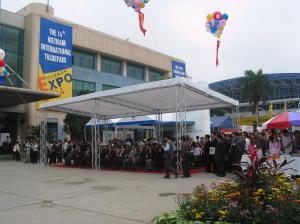
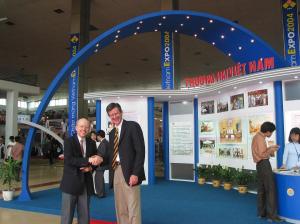 James Rockwell and I at the opening of the Vietnam Trade Expo
2004
James Rockwell and I at the opening of the Vietnam Trade Expo
2004
At Viet Expo 2004 which was opened by the Minister of
Commerce and later visited by Vietnam’s President, our group observed a
host of Vietnamese and primarily Asian companies displaying their
product. According
to Press reports there were over 700 stalls with over 580 from
Vietnamese
companies and over 150 from 20 foreign countries who participated in
the
show. The event, however, which was at the Giang Vo Exhibition
Center
suffered from a lack of air conditioning and a failure to restrict the
first
day to buyers only with public days to take place later. As
a result, the event frankly compared less favorably to similar events
in
Bangkok, Kuala Lumpur and Hong Kong. Many excellent companies
both
domestic and international were represented much more can be done to
make
buyers comfortable and to profesionalize the event.
In talks with Vietnamese officials both at the Fair and in their
offices, it is obvious that Vietnamese officials see the current drop
in FDI, the
tremendous pull effect that China is exerting over FDI worldwide,
competitive
pressures to Vietnams market from a burgeoning Chinese consumer market
and
other factors and have decided that Vietnam must be more transparent
and
try harder to attract investment. This change in attitude I
sensed
is real and this was confirmed to me by many local residents, both
Vietnamese
and foreign. This bodes well for Vietnam and for investors and
the
Embassy and others noted that American and Western companies are
looking
at Vietnam as a place to locate a portion of their Asian production as
an
insurance policy in the event that the situation in China should become
less
attractive. This is further supported by a recent Japanese report
that
rated Vietnam in the number four slot after China, Taiwan and Thailand
as
a site for Japanese investment in Asia.
A further pull is regional integration which since 1997 has been moving
ahead in Southeast Asia and more recently through the active diplomacy
of Thailand, China and more recently Japan in Asia as a whole.
The five Northeast Asian nations and 10 Southeast Asian Nations
collectively have a
total population of 1.7 billion and US$7 trillion in gross domestic
product (calculated at current exchange rates). Freer trade
mostly now with China in agriculture products and with Southeast Asia
in a larger variety of goods offers access to a large and rapidly
growing market that is increasingly attracting attention in corporate
boardrooms.
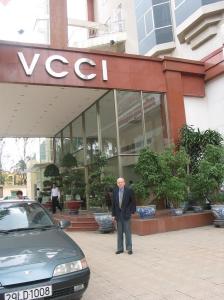
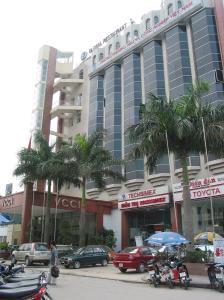 Vietnam Chamber of Commerce and Industry (VCCI) Building
Vietnam Chamber of Commerce and Industry (VCCI) Building
Later in the week, my wife, Soraya, and I spoke at a
training session at the Vietnamese Chamber of Commerce and Industry for
about 25
Vietnamese private and state owned companies about how to attract
increased
business and contact from international buyers through proper use of
the
internet, e-mail and e-commerce. The interest level was high and
the
questions from the companies excellent. From these, it was
obvious
that even in State run companies, no one is waiting around for the
Vietnamese
government to help them compete more effectively with China and to
attract
foreign buyers despite their smaller financial resources, still weak
English
skills and other impediments. Managers and mid level
administrators
all realize that business waits for no one and that that if their
company
is to receive the business that they must be actively engaged, fully
committed
to quality and in close communication with their customers.
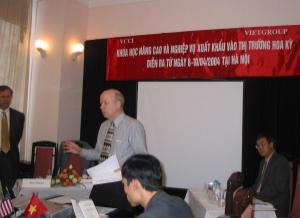
At the training course for Vietnamese entrepreneurs
on how to export to the US
|
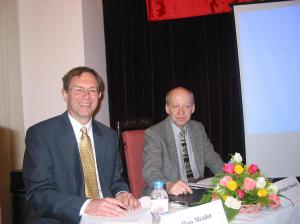
With Ross Meador, a lawyer in Berkley, California,
who also conduct several presentations on export/import law and
regulations
|
Although Vietnam is still a poor country, it has always been rich in
the beauty of its people. Vietnamese young woman closely follow
western fashion but also subscribe to fashions that display their lithe
bodies which are a welcome change to the obese physics’ that one
sees in most western airports and public places. Despite this
slim population, Hanoi hosts a wealth of delicious and attractive
restaurants. As I noted earlier, the central area around the
Opera House is the home to many of these. These restaurants are
in a class with anything in the region. One
of those we enjoyed was Billy Chin’s which is located at number one Ba
Trieu and sits directly across from Hoan Kiem lake where we dined on
excellent
western and Asian fusion dishes in very comfortable surroundings.
We
also had a very nice meal at the Press Club which is open to the
public,
at the newly opened Sheraton and at a small French Vietnamese
restaurant
directly across from the Opera House. The quality of the food and
the
fact that not one of our group was taken ill through our nearly one
week
stay shows that gastronomically Hanoi is improving.
Although it is hard to put a nearly one week visit into a few words and
although I am hesitant to both be too critical or overly optimistic,
Hanoi seems to me to be both little changed although I sense that the
government and perhaps the people are all building the consensus for a
new period of change that will be necessary for more fundamental
changes in business and work if Vietnam is to progress further and to
compete effectively with China for FDI, consumer sales, etc.
Vietnam and particularly in my view the North does offer opportunities
for those who do their homework, negotiate hard before committing
resources and area willing to make the commitment in
time and effort that a successful investment requires. A
visit to see and investigate the possibilities is much recommended.
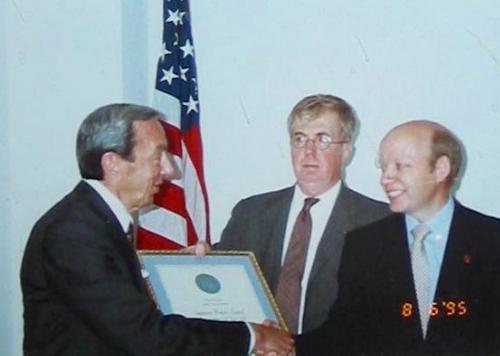
|
Mr. Runckel was the first
permanently assigned U.S. diplomat to return to Vietnam after the
Vietnam War. In 1997, he was awarded the U.S. Department of
States highest award for service, the Distinguished Honor Award, for
his contribution to improving U.S.-Vietnam relations. Mr. Runckel
is one of only two non-Ambassadors to receive this award in the
200-year history of the U.S. diplomatic service.
|
About the Author:
Christopher
W. Runckel,
a former senior US diplomat who served in many counties in Asia, is a
graduate of the University of Oregon and Lewis and Clark Law School. He
served as Deputy General Counsel of President Gerald Ford’s
Presidential Clemency
Board. Mr. Runckel is the principal and founder of Runckel &
Associates, a Portland, Oregon based consulting company that
assists businesses expand business opportunities in Asia. (www.business-in-asia.com)
Until
April of 1999, Mr. Runckel was
Minister-Counselor of the US Embassy in Beijing, China. Mr. Runckel
lived and worked in Thailand for over six years. He was the first
permanently assigned U.S. diplomat to return to Vietnam after the
Vietnam War. In 1997, he was awarded the U.S. Department of States
highest award for service, the Distinguished Honor Award, for his
contribution to improving U.S.-Vietnam relations. Mr. Runckel is one of
only two non-Ambassadors to receive this award in the 200-year history
of the U.S. diplomatic service.
Copyright, 2008
© Runckel & Associates
www.Business-in-Asia.com



